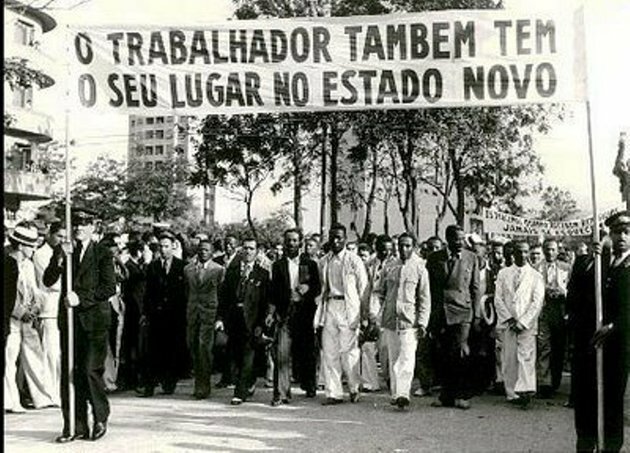THE It was Vargas corresponds to the period in which Getúlio Vargas (1882-1954) governed Brazil in three moments:
- Provisional Government: 1930-1934
- constitutional government: 1934-1937
- new state: 1937-1945
Provisional Government (1930-1934)
The Provisional Government was characterized by the beginning of the process of centralization of power, the elimination of legislative bodies at the federal, state and municipal levels and the absence of elections.
New ministries were also created such as the Ministry of Labour, Industry and Commerce and the Ministry of Education and Health, both in 1930.
These measures, added to the appointment of state interventors, caused discontent in several states. In particular, the state of São Paulo, which took up arms against Getúlio Vargas, in an uprising known as the Constitutionalist Revolution.
After the Constitutionalist Revolution of 1932, Getúlio Vargas had to promote legislative elections and summon the Constituent Assembly to draft a new Magna Carta in 1934.
In this, there were important political changes, such as the female vote, established free and compulsory primary education, and created the Labor Court.

Constitutional Government (1934-1937)
During the Constitutional Government, the Communist Revolt, known as Intentona, takes place in opposition to the government.
The Brazilian Communist Party had been illegal since 1927 and many of its members participated in the ANL (Aliança Nacional Libertadora). However, this would also be extinct and several of its members were persecuted.
Some sectors of the PCB and ANL try to seize power through arms and then try to articulate the Communist Intentona, of 1935, directed by Luís Carlos Prestes (1898-1990). The coup did not materialize and repression was fierce, including torture and illegal arrests by the political police led by Filinto Müller (1900-1973).
Two years later, in 1937, Getúlio Vargas claims that there was another attempted communist coup, known as Cohen Plan. This will be the pretext for closing the Congress, canceling the presidential elections and nullifying the 1934 Constitution.
In fact, the plan was carried out by the integralist captain and Vargas ally, Olímpio Mourão Filho (1900-1972), and used by the government to justify the state of siege and inaugurate the Estado Novo.
Estado Novo (1937-1945)

The Estado Novo is remembered by History in a contradictory way.
The Estado Novo is considered the most repressive and dictatorial period of the Vargas era, when the 1937 Constitution. At the same time it is remembered as a golden age where labor rights were created.
The new Magna Carta extinguished political parties, instituted the corporate regime and ended the independence between the three powers. Because it was inspired by the Polish Constitution of 1926, it was nicknamed "Polish".
Furthermore, from November 1937 onwards, Vargas imposed censorship on the media to prevent the media from spreading any criticism of the government.
In 1938, indignant with the centralist course that the government was taking, the Brazilian Integralist Action plans a coup. Led by Plínio Salgado (1895-1975) and Gustavo Barroso (1888-1959), the Integralists try to seize power, but are defeated and their participants are imprisoned or exiled.
On the economic front, the Vargas Era is characterized by nationalization measures, as well as carrying out its labor policy with the conception of the CLT (Consolidation of Labor Laws). At the legislative level, it established the Penal Code and the Code of Criminal Procedure.
Vargas Era and World War II
With the outbreak of World War II, in 1939, Brazil took the decision to remain neutral in the face of the European conflict.
However, in the government there were those who were in favor of supporting the Axis and those who wished to draw closer to the Allies.
Due to American pressure, Getúlio Vargas decides to declare war on Germany and, later, send soldiers to Europe and give an air base to the Americans in Natal (RN).
In exchange, loans were granted and the Brazilian Army's armament was modernized.
See too: Good Neighbor Policy
End of the Vargas Era
The contradiction between fighting a dictatorship and living in a regime without democracy determined the beginning of the end of the Vargas era.
Several intellectuals, student associations and even part of the military began to openly protest against the Vargas regime.
On October 29, 1945, Getulio Vargas was deposed by a military coup and by the U.DN. (National Democratic Union), being driven to exile in his hometown, São Borja / RS.

However, in 1951, he would return to the presidency, running for the Brazilian Labor Party (PTB). In this mandate, achieved by popular vote, he laid the foundations for the creation of Petrobras.
Vargas committed suicide in the Palácio do Catete on August 24, 1954 with a shot in the chest. His will-letter explained the reasons for his decision with a famous phrase: "I leave life to enter History".
Curiosities about the Vargas era
- Getúlio Vargas introduced the cult of personality to the leader, civic parades and the great gatherings that acclaimed him and sang together in choirs, often conducted by Hector Villa-Lobos.
- The Vargas era was marked by labor laws as the institution of the minimum wage, implementation of Labor Law (CLT) and work permit, with a 48-hour workweek and vacations paid.
We have more texts on the topic for you:
- 1930 revolution
- Female vote in Brazil
- 1934 Constitution
- American way of life
- History Questions in Enem
- Brazilian History Questions in Enem
- Questions about WWII
- The History of Brazil

